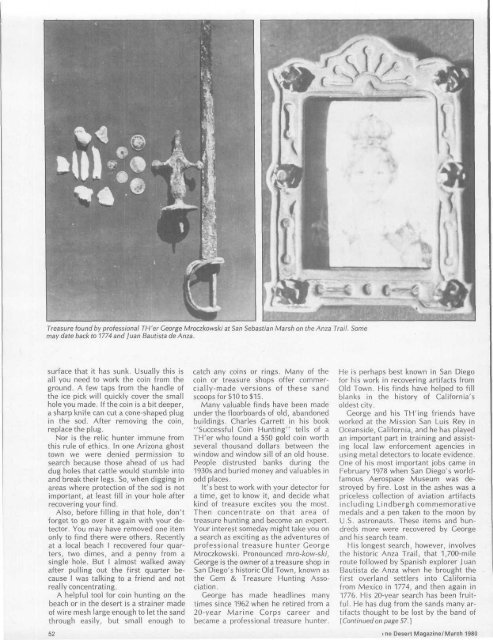BYWAYS PLUS: DATES! - Desert Magazine of the Southwest
BYWAYS PLUS: DATES! - Desert Magazine of the Southwest
BYWAYS PLUS: DATES! - Desert Magazine of the Southwest
Create successful ePaper yourself
Turn your PDF publications into a flip-book with our unique Google optimized e-Paper software.
Treasure found by pr<strong>of</strong>essional TH'er George Mroczkowski at San Sebastian Marsh on <strong>the</strong> Anza Trail. Some<br />
may date back to 1774 and Juan Bautista de Anza.<br />
surface that it has sunk. Usually this is<br />
all you need to work <strong>the</strong> coin from <strong>the</strong><br />
ground. A few taps from <strong>the</strong> handle <strong>of</strong><br />
<strong>the</strong> ice pick will quickly cover <strong>the</strong> small<br />
hole you made. If <strong>the</strong> coin is a bit deeper,<br />
a sharp knife can cut a cone-shaped plug<br />
in <strong>the</strong> sod. After removing <strong>the</strong> coin,<br />
replace <strong>the</strong> plug.<br />
Nor is <strong>the</strong> relic hunter immune from<br />
this rule <strong>of</strong> ethics. In one Arizona ghost<br />
town we were denied permission to<br />
search because those ahead <strong>of</strong> us had<br />
dug holes that cattle would stumble into<br />
and break <strong>the</strong>ir legs. So, when digging in<br />
areas where protection <strong>of</strong> <strong>the</strong> sod is not<br />
important, at least fill in your hole after<br />
recovering your find.<br />
Also, before filling in that hole, don't<br />
forget to go over it again with your detector.<br />
You may have removed one item<br />
only to find <strong>the</strong>re were o<strong>the</strong>rs. Recently<br />
at a local beach I recovered four quarters,<br />
two dimes, and a penny from a<br />
single hole. But I almost walked away<br />
after pulling out <strong>the</strong> first quarter because<br />
I was talking to a friend and not<br />
really concentrating.<br />
A helpful tool for coin hunting on <strong>the</strong><br />
beach or in <strong>the</strong> desert is a strainer made<br />
<strong>of</strong> wire mesh large enough to let <strong>the</strong> sand<br />
through easily, but small enough to<br />
52<br />
catch any coins or rings. Many <strong>of</strong> <strong>the</strong><br />
coin or treasure shops <strong>of</strong>fer commercially-made<br />
versions <strong>of</strong> <strong>the</strong>se sand<br />
scoops for $10 to $15.<br />
Many valuable finds have been made<br />
under <strong>the</strong> floorboards <strong>of</strong> old, abandoned<br />
buildings. Charles Garrett in his book<br />
"Successful Coin Hunting" tells <strong>of</strong> a<br />
TH'er who found a $50 gold coin worth<br />
several thousand dollars between <strong>the</strong><br />
window and window sill <strong>of</strong> an old house.<br />
People distrusted banks during <strong>the</strong><br />
1930s and buried money and valuables in<br />
odd places.<br />
It's best to work with your detector for<br />
a time, get to know it, and decide what<br />
kind <strong>of</strong> treasure excites you <strong>the</strong> most.<br />
Then concentrate on that area <strong>of</strong><br />
treasure hunting and become an expert.<br />
Your interest someday might take you on<br />
a search as exciting as <strong>the</strong> adventures <strong>of</strong><br />
pr<strong>of</strong>essional treasure hunter George<br />
Mroczkowski. Pronounced mro-kow-ski,<br />
George is <strong>the</strong> owner <strong>of</strong> a treasure shop in<br />
San Diego's historic Old Town, known as<br />
<strong>the</strong> Gem & Treasure Hunting Association.<br />
George has made headlines many<br />
times since 1962 when he retired from a<br />
20-year Marine Corps career and<br />
became a pr<strong>of</strong>essional treasure hunter.<br />
He is perhaps best known in San Diego<br />
for his work in recovering artifacts from<br />
Old Town. His finds have helped to fill<br />
blanks in <strong>the</strong> history <strong>of</strong> California's<br />
oldest city.<br />
George and his TH'ing friends have<br />
worked at <strong>the</strong> Mission San Luis Rey in<br />
Oceanside, California, and he has played<br />
an important part in training and assisting<br />
local law enforcement agencies in<br />
using metal detectors to locate evidence.<br />
One <strong>of</strong> his most important jobs came in<br />
February 1978 when San Diego's worldfamous<br />
Aerospace Museum was destroyed<br />
by fire. Lost in <strong>the</strong> ashes was a<br />
priceless collection <strong>of</strong> aviation artifacts<br />
including Lindbergh commemorative<br />
medals and a pen taken to <strong>the</strong> moon by<br />
U.S. astronauts. These items and hundreds<br />
more were recovered by George<br />
and his search team.<br />
His longest search, however, involves<br />
<strong>the</strong> historic Anza Trail, that 1,700-mile<br />
route followed by Spanish explorer Juan<br />
Bautista de Anza when he brought <strong>the</strong><br />
first overland settlers into California<br />
from Mexico in 1774, and <strong>the</strong>n again in<br />
1776. His 20-year search has been fruitful.<br />
He has dug from <strong>the</strong> sands many artifacts<br />
thought to be lost by <strong>the</strong> band <strong>of</strong><br />
[Continued on page 57. ]<br />
me <strong>Desert</strong> <strong>Magazine</strong>/March 1980
















